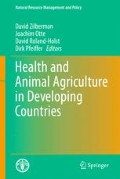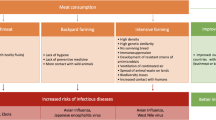Abstract
Throughout history, animal husbandry has been a central component of agriculture and livestock has been central to agrofood systems. Animals have provided rural societies with a broad spectrum of products and services, including food, energy, fertilizers, traction and transport, pest control, security, etc. Despite the immense benefits enjoyed by humans from this symbiotic relationship, coexistence with domestic animals also poses serious risks. Most important among these are infectious diseases of animal origin that can affect humans (zoonoses). These have been prominent among the many pandemics that have wiped out millions of people and communities since the earliest human settlements. To cite a relatively recent example, the 1918–1920 Spanish Flu Pandemic, caused by a virus with Avian origins, was responsible for tens of millions of deaths worldwide (Murray et al. 2006). Recent research on the human genome suggests that we have acquired resistance to such diseases over a much longer history of recurrent viral threats.
You have full access to this open access chapter, Download chapter PDF
Similar content being viewed by others
Keywords
- Supply Chain
- Severe Acute Respiratory Syndrome
- Bovine Spongiform Encephalopathy
- Zoonotic Disease
- Severe Acute Respiratory Syndrome
These keywords were added by machine and not by the authors. This process is experimental and the keywords may be updated as the learning algorithm improves.
Throughout history, animal husbandry has been a central component of agriculture and livestock has been central to agrofood systems. Animals have provided rural societies with a broad spectrum of products and services, including food, energy, fertilizers, traction and transport, pest control, security, etc. Despite the immense benefits enjoyed by humans from this symbiotic relationship, coexistence with domestic animals also poses serious risks. Most important among these are infectious diseases of animal origin that can affect humans (zoonoses). These have been prominent among the many pandemics that have wiped out millions of people and communities since the earliest human settlements. To cite a relatively recent example, the 1918–1920 Spanish Flu Pandemic, caused by a virus with Avian origins, was responsible for tens of millions of deaths worldwide (Murray et al. 2006). Recent research on the human genome suggests that we have acquired resistance to such diseases over a much longer history of recurrent viral threats.
While humans are gradually shifting away from reliance on animal traction and related services, rising incomes and population have built momentum for drastic changes in livestock consumption and production patterns, heralding a new “food revolution” (Delgado et al. 1999) driven by the emergent middle classes around the world. In response to such demanding forces, the livestock sector is changing at every level. Industrial livestock production systems are being introduced or expanded throughout the world while hundreds of millions of individual farmers continue to raise livestock in traditional production systems. These two archetypes and all production systems in between are evolving under rapidly changing and intensifying forces, including expanding markets, global competition, increased supply chain complexity, food safety and other product standards, disease risk management, etc. Global food trade has risen more than 400% over the last generation and, with this increased product mobility, has come rapid diffusion of disease risks.Footnote 1
As this process has accelerated, several large-scale outbreaks, such as Highly Pathogen Avian Influenza (HPAI type H5N1) or Avian Flu, Swine Flu (H1N1), Severe Acute Respiratory Syndrome (SARS), and Bovine Spongiform Encephalopathy (BSE or “Mad Cow” disease), have asserted themselves in less than a decade. Effective responses to these new threats have to be based on better public and private understanding of zoonotic-risk generation and transmission, and these insights must be integrated into a new generation of policies and practices governing animal production, processing, supply chain management, and public health. Given the complexity and socioeconomic extent of agrofood systems, meeting these challenges successfully requires multidisciplinary research, insights, and policy guidance.
This book introduces such an approach, applied to one of the leading modern pandemic threats, HPAI. While the work reported, here, is of general relevance to past, present, and future zoonotic diseases, HPAI, itself, remains a very serious threat to animal and human populations. The present research was part of a leading international effort to understand and address this disease’s emergence and the larger implications of policy responses to it. The HPAI is extremely contagious and deadly to poultry, much less contagious but very deadly to people, and is still undergoing rapid mutation and reassortment in an established reservoir of tens of billions of domestic animals/poultry. To better understand this threat and devise more socially effective defenses against it, the UK Department for International Development supported our multidisciplinary HPAI research project for Southeast Asia and Africa.
The results of this research are reported in five thematic sections below. Part I provides an historical perspective on zoonotic-disease control, reviewing experience with one of the most significant zoonotic diseases—Bovine Tuberculosis. This section also presents a conceptual framework to characterize the evolution of livestock production and supply chains using Viet Nam’s poultry sector as a case study. Part II presents different perspectives on managing animal disease. Zilberman et al. present a farm-level model that reveals how incentives, including penalties for selling sick animals, will affect production level, monitoring, and culling choices. While this model can be applied to traditional as well as modern livestock operations, Hennessy and Wang investigate how adoption of industrial livestock methods affects the economics of livestock production. Modern systems are closed systems that are designed to control infectious diseases and reduce production costs. Hennessy and Wang investigate how the adoption of such system configurations and technologies affects the scale of production and the size of the industry.
One of the main challenges in developing models of disease control is integrating epidemiology and economics, i.e., the biological and behavioral realities that combine to manifest livestock disease and hold the keys to managing that risk. Horan, Wolf, and Fenichel present a dynamic framework that demonstrates how different epidemiological features affect management choice and optimality of outcomes. Wang, Fenichel, and Perrings develop a framework to deal with animal diseases in the context of international trade and movement of livestock, showing how different arrangements will affect both the magnitude and distribution of risk among different locations and producers. The control of animal disease is technology dependent, which, in turn, is dependent on public research. Sproul, Zilberman, and Roland-Holst develop a rule of thumb to determine global investment in control of zoonotic diseases based on the notion of the value of life. The investment in disease control and livestock production depends on consumers’ willingness to pay for the various livestock product characteristics. Heiman, McWilliams, and Zilberman develop a hedonic price approach to assess how different characteristics of meat products affect the value perceived by consumers and thus establish the earning capacity of the livestock industry.
While Part II emphasizes economic principles, Part III is devoted to epidemiological modeling and alternative strategies to control animal disease, exemplified, here, by HPAI. Avian Flu attracted considerable media attention, because this virus has been shown to produce severe disease in humans with a case-fatality rate of approximately 50%. While there is fear that the virus could evolve into a strain capable of sustained human-to-human transmission, the virus’s greatest impact to date has afflicted highly diverse poultry industries in several affected countries. Thus, HPAI control measures have, until now, focused on implementing prevention and eradication measures in poultry populations, with more than 175 million birds culled in Southeast Asia alone.
Fournié, Glanville, and Pfeiffer present an overview of HPAI type H5N1, providing a history that includes major outbreaks in Asia as well as its spread westward, among species, and within regions. Fournié et al. develop a general framework to model the spatial spread of a livestock disease over time and apply it to Avian Flu. In addition, they model several control strategies, including vaccinations and movement restrictions. Hinrichs and Otte analyze some of the economic and technological issues that are associated with alternative vaccination strategies to control Avian Flu, taking into account factors that can affect the performance of such strategies. One of the key factors affecting the spread of HPAI is the movement of poultry over space. Van Kerkhove presents a framework to analyze the impact of bird movement and interaction on the spread of Avian Flu in bird and human populations in Cambodia.
Part IV is devoted to special case studies that emphasize the diverse institutional realities associated with the HPAI control at different locations. Burden gives an overview of a disease-control programs that includes disease-prevention steps, various responses to outbreaks (including culling), as well as compensation. He emphasizes the role of alternative financial arrangements, such as insurance, in triggering these responses throughout the supply chain. Tiongco et al. develop a quantitative framework to analyze producer responses to Avian Flu with respect to information, size, and perception, applying it to case studies in Kenya. Rich and Perry present an overview of the major livestock disease threats in Africa and the different strategies taken to control them. Three other studies investigate alternative strategies to promote food safety and sustainability among small poultry producers in Southeast Asia. Heft-Neal et al. investigate the use of poultry contracting in Thailand. Behnke, Roland-Holst, and Otte investigate the potential of microcontracting to develop a sustainable supply chain in Lao PDR. And Heft-Neal, Roland-Host, and Otte analyze the changes in the structure of the poultry sector in Thailand and its capacity to deal with HPAI in Thailand. Finally, Jin and Mu report on consumer livestock valuation—willingness to pay for chicken products in China. Part V offers general conclusions and discussion of new research directions.
Notes
- 1.
Indeed, some of the most deadly modern zoonotic diseases, such as HIV and the Ebola virus, were apparently long endemics in local animal populations but have only recently become larger human health threats.
References
Delgado, Christopher, Mark Rosegrant, Henning Steinfeld, Simeon Ehui, and Claude Courbois. Livestock to 2020: The Next Food Revolution. Nairobi, Kenya: International Food Policy Research Institute, May, 1999.
Murray, Christopher, Alan D. Lopez, Brian Chin, Dennis Feehan, and Kenneth H. Hill. “Estimation of Potential Global Pandemic Influenza Mortality on the Basis of Vital Registry Data from the 1918-20 Pandemic: A Quantitative Analysis.” The Lancet, Vol. 368, No. 9554 (December, 2006), pp. 2211–2218.
Author information
Authors and Affiliations
Corresponding author
Editor information
Editors and Affiliations
Rights and permissions
Copyright information
© 2012 Food and Agriculture Organization of the United States
About this chapter
Cite this chapter
Zilberman, D., Otte, J., Roland-Holst, D., Pfeiffer, D. (2012). Introduction. In: Zilberman, D., Otte, J., Roland-Holst, D., Pfeiffer, D. (eds) Health and Animal Agriculture in Developing Countries. Natural Resource Management and Policy, vol 36. Springer, New York, NY. https://doi.org/10.1007/978-1-4419-7077-0_1
Download citation
DOI: https://doi.org/10.1007/978-1-4419-7077-0_1
Published:
Publisher Name: Springer, New York, NY
Print ISBN: 978-1-4419-7076-3
Online ISBN: 978-1-4419-7077-0
eBook Packages: Business and EconomicsEconomics and Finance (R0)




